Nepal Biogas Plant -- Construction Manual
Source :http://www.builditsolar.com/Projects/BioFuel/methane_nepal.html
Construction Manual for GGC 2047 Model Biogas Plant
Biogas Support Programme (BSP)
P.O. Box No.: 1966, Kathmandu, Nepal
September, 1994
Sundar Bajgain
Programme Manager
Biogas Support Programme
Tel. 5521742, 5534035
Email snvbsp@wlink.com.np
Scanned by Biofuel Mailing List member Olivier Morf (with thanks)
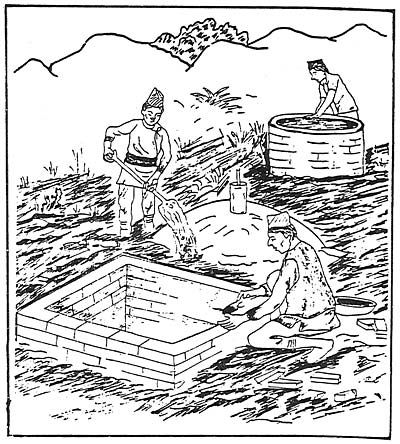
Introduction
The success or failure of any biogas plant mainly depends upon the quality of construction works. To come to a successfully constructed biogas plant, the mason should not only respect the dimensions as indicated on the drawing but also follow the correct construction method. Hereunder, in a step-by-step fashion, the right construction method of the 2047 design GGC model biogas plant is given.
1. Different Sizes of Plant
To become eligible to receive the investment subsidy provided by His Majesty's Government of Nepal under the Biogas Support Programme (BSP), only the 2047 design GGC model plants of 4, 6, 8, 10, 15 and 20 cubic meters capacity should be constructed. If the design and size of the plant other than mentioned above is chosen, the subsidy is not allowed. The table below gives some relevant data about these six different sizes of biogas plants.
| Table 1 |
| S.N. | Size of Plant | Daily Fresh Dung (Kg) | Daily Water Liters | Approx. No. Cattle Required |
| 1. | 4 | 24 | 24 | 2 - 3 |
| 2. | 6 | 36 | 36 | 3 – 4 |
| 3. | 8 | 48 | 48 | 4 – 6 |
| 4. | 10 | 60 | 60 | 6 – 9 |
| 5. | 15 | 90 | 90 | 9 – 14 |
| 6. | 20 | 120 | 120 | 14 and more |
| * Plant size is the sum of digester volume and gas storage
** Based on a hydraulic retention time of 70 days |
A biogas plant consists of five main structure or components. The required quantity of dung and water is mixed in the inlet tank and this mix in the form of slurry is allowed to be digested inside the digester. The gas produced in the digester is collected in the dome, called as the gasholder. The digested slurry flows to the outlet tank from the dig through the manhole. The slurry then flows through overflow opening to the compost pit where it is collected and composted. The gas is supplied to the point of application through the pipeline.
Before deciding the size of plant, it is necessary to collect dung for several days to determine what is the average daily dung production. The amount of dung daily available helps in determining the capacity of the plant. For example, if 55 kg of dung is collected daily, a 8 m3 plant has to be selected. It should be kept in mind that at least six kg dung is required for 1 m3 of plant capacity. The important point to be considered is that the size of plant has to be selected on basis of available dung not on the family size.
If a plant is underfed, the gas production will be low; in this case, the pressure of the gas might not be sufficient to displace the slurry in the outlet chamber. This means that amount of slurry fed into the digester is more than the amount of slurry thrown out from the outlet. This will cause the slurry level to rise in the digester; gasholder and it may eventually enter to the gas pipe and sometimes, to the gas stove and lamp while opening the main valve. Therefore, the slurry should always be fed according to the prescribed amount as indicated, in the above table.
2. Construction Materials
If the construction materials to be used in the plant construction such as cement, sand, aggregate etc. are not of good quality, the quality of plant will be poor even if design and workmanship involved are excellent. In order to select these materials of best quality, their brief description regarding the specifications has been given hereunder. (The list construction materials are given in annex 1).
a) Cement
The cement to be used in the plant construction has to be of high quality portland cement from a brand with a good reputation. It must be fresh, without lumps and stored in a dry place. Bags of cement should never be stacked directly on the floor or against the walls but wooden planks should be placed on the floor to protect cement from dampness.
b) Sand
Sand for construction purpose must be clean. Dirty sand has a very negative effect on the strength of the structure. If the sand contains 3% or more impurities, it must be washed. The quantity of impurities especially the mud in the sand can be determined by a simple test using a bottle. This is called the 'bottle test'. For this test, small quantity of sand is put in the bottle. After this, water is poured in and the bottle is stirred vigorously. The bottle is than left stationary to allow the sand to settle down. The particles of sand are heavier than that of mud so it settles down quickly. After 20-25 minutes, the layer of mud verses sand inside the bottle are measured. Course and granular sand can be used for concreting work but fine sand will be better for plastering work.
c) Gravel
Gravel should not be too big or very small. It should not be bigger than 25% of the thickness of concrete product where it is used in. As the slabs and the top of the dome are not more than 3" thick, gravel should not be larger than 0.75" (2 cm) in size. Furthermore, the gravel must be clean. If it is dirty, it should be washed with clean water.
d) Water
Water is mainly used for preparing the mortar for masonry work, concreting work and plastering. It is also used to soak bricks/stones before using them. Besides these, water is also used for washing sand and aggregates. It is advised not to use water from ponds and irrigation canals for these purposes, as it is usually too dirty. Dirty water has an adverse effect the strength of the structure; hence water to be used must clean.
e) Bricks
Bricks must be of the best quality locally available. When hitting two bricks, the sound must be clear. They must be well baked and regular in shape. Before use, bricks must be soaked for few minutes in clean water. Such bricks will not soak moisture) from the mortar afterwards.
f) Stones
If stones are to be used for masonry work, they have to be clean, strong and of good quality. Stones should be washed if they are dirty.
3. Construction Site Selection
The following points should be kept in mind when deciding on a site for biogas plant construction.
- For proper functioning of the plant, the right temperature has to be maintained in the digester. Therefore, a sun site has to be selected.
- To make plant operation easy and to avoid wastage raw material specially the dung, the plant must be as close as possible to the stable (cattle shed) and water source. If the nearest water source is at a distance of more than 20 minutes walk, the burden of fetching water becomes too much and no plant should be installed in such places.
- If longer gas-pipe is used the cost will be increased, the pipe is expensive. Furthermore, longer pipe increase the risk of gas leakage due to more joints in it. The main valve has to be opened and closed before and after use Therefore, the plant should be as close as possible to the point of use so that the above problems are eliminated.
- The edge of the foundation of the plant should be at least two meters away from the house or any other building to avoid risk of damages.
- The plant should be at least 10 metres away from the well or any other under ground water sources to protect water from pollution.
4. Digging and Pit Depth
When a suitable site is selected, a small peg has to be stuck in the ground at the centre spot of the digester. A cord has to be attached to this peg with the length indicated on the drawing under dimension 'C'. Now this cord is the radius of the digester pit and the circumference can be decided by moving the edge of the cord on circular fashion. The pit depth is indicated on the drawing under dimension 'E'. The excavation work should only be started after deciding the location of manhole and outlet tank. The pit wal1s should be as vertical as possible and, most important, the pit bottom must be leveled and the earth must be untouched.
While digging, excavated soil should be thrown at least one foot away from the layout, so that it does not fall inside the pit when the construction work is in progress.
After digging the pit, a suitable arrangement must be made for the inlet pipe(s).
If because of hard rock or under ground water, the right depth can not be achieved, the pit has to be made as deep as possible, while after completion of the structure some protective measure have to be constructed so that the wal1s of outlet and dome is supported well from outside. (see chapter 10)
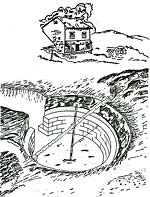
Bigger image
5. Construction of Round-wall
At the centre of the pit, a straight rod or pipe (the 0.5" GI gas pipe) must be placed in an exact vertical position. At ground-level, a heavy pole or pipe has to be placed horizontally on the centre of the pit. The vertical pipe can now be secured to the horizontal pipe or pole. After securing, the vertical pipe has again to be checked whether it is still in the right position.
A string or wire can now be attached to the vertical pipe. The length of this wire can be found on the drawing under the dimension 'F. One cm has to be added to this length to allow space for plastering. Every brick or stone which is laid in the round-wall has to be exactly F+ 1 cm away from the vertical pipe.
After deciding the radius of digester, the round wall is started to be constructed. The first row of bricks must be positioned on their sides so that a 4.5" high, 9" wide base is made. It is essential that first row is placed on a firm, untouched and level soil. The next rows of bricks can be positioned on their lengths so that the wall thickness becomes 4.5".
It is not necessary to make pillars in the wall but the backfilling between wall and pit-side must be compacted with great care. This backfilling has to be done in the morning before starting the construction work. Earth should be well compacted by adding water and gentle ramming all along the circumference of the digester. Poor compaction will lead to cracks in round-wall and dome.
If stone is used for the construction of round wall, the wall should rest against the pit-side as it is difficult to have proper backfilling because of the irregular shape of the outside of the stone wall. The cement mortar used can be 1 cement-4 sand to I cement-6 sand depending on the quality of the sand.
The height of the round-wall can be found on the drawing under dimension 'H' when measured from the finished floor. The dung inlet pipe and toilet pipe must be placed in position when the round-wall is 35 cm high. To reduce the risk of blockages, the inlet pipe(s) must be placed as vertically as practical possible.
Exactly to the opposite of the dung inlet pipe, a 60 cm wide opening must be left in the round-wall which acts as manhole. The digested slurry also flows out to the outlet tank through this opening. The inlet pipe from the latrine should be placed as close as possible with the dung inlet pipe with a maximum distance of 45 degrees from the dung' inlet on the dung inlet-centres-manhole line (hartline).
When the round-wall has reached the correct height, I inside must be plastered with a smooth layer of cement mortar with a mix of 1 cement - 3 sand. The digester floor can made from bricks or small stones with plaster in cement mortar.

6. Dome Construction
When the construction works of round wall as described above is completed than the dome has to be constructed. Before filling the pit with earth to make the mould for dome, backside of the round wall should be filled with proper compacted back-filling. If this is not done, the pressure of earth for the mould can lead to cracks in the round-wall.
On the vertical centre pipe a mark has to be made - distance "J", as given in the drawing, from the finished floor. The compacted earth has to reach this level. The vertical pipe can now be removed by pulling it upwards. It has to be replaced by a shorter O0.5" dia. pipe, approx. 0.5 metres length in the earth exactly at the same spot. Now the template should be used to make the shape of the dome. The top of the round-wall wall must be clean when the template is in use. The template can be checked by making sure the top is horizontal and the side exactly vertical. Furthermore, the part of the template that touches the round-wall must be in the same position all over the round wall.
It is important that the earth of the mould is well compacted. If the earth is further compressed after casting the dome, by its own weight and that of the concrete, it can lead to cracks in the dome. When the earth mould has the exact shape of the template, a thin layer of fine sand has to be spread on the mould-top by gently patting it on the surface. Any excess sand or soil that falls on the round-wall has to be removed.
The earth used for the mould has to be damp to prevent dry earth from soaking up water from freshly casted concrete.
Before starting the casting work enough manpower and construction materials like sand, gravel, cement and water has to be collected on the site. The casting has to be done as quickly as possible and without interruptions as this will negatively affect the quality of the cast. A constant, adequate supply of concrete (mix: 1 cement, 3 sand, 3 gravel) must be made for the mason. No concrete older than 30 minutes should be used.
A special care should be taken to maintain the thickness of dome while casting, i.e. the thickness in and near the edges should be more than the thickness in the centre. For 4, 6, 8 and 10 m3 plant, the thickness in the edge should be 25 cm where as the thickness in the centre should be 7 cm. Similarly, for 15 and 20 m3 plants, the thickness in the centre should be 8 and 9 cm respectively and the thickness in the age I should be 25 cm.
The small pipe on the top of the mould must be left in place till the main gas pipe is installed. This is to make sure that the main gas pipe is exactly in the centre.
Already during the casting, the concrete has to be protected against strong sunlight by covering it with jute bags or straw mats. This protection has to be left in place for at least one week. The day after the casting, the turret must be made.
Any delays can lead to leakage between main gas pipe and dome. Also from the day after the casting onwards, the dome has to be sprinkled with water 3 to 4 times a day which known as curing.
After approximately one week, depending temperature the earth of the mould can be removed through the manhole. When all earth is removed, the inside of the dome has to be thoroughly cleaned with a brush and clean water
On the clean surface the following plaster coats have to be applied to make the dome gas-tight.
- Cement-water flush
- 10 mm layer, 1 cement - 2 sand, plaster
- 5 mm layer, 1 cement - 1 sand, punning.
- Cement/acrylic emulsion paint coating, 1.5 paint-20 cement
- Cement/acrylic emulsion paint coating, 1 paint -2 cement
A plaster Coat must be at least one day old before next layer can be put on. When a layer of plaster is applied, the work must be executed with the greatest care and without interruptions. The well functioning of the plant is very depending on the gas tightness of the dome.
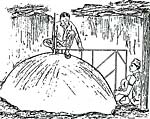
Bigger image
7. Construction Outlet Chamber
To construct the outlet tank, excavation has to be done just behind the manhole. The level of excavation can be measured from the digester floor by taking the dimension 'I' minus the thickness of the digester floor. The earth behind the manhole and under the outlet floor has to be very well compacted otherwise cracks will occur.
The inside dimensions of the outlet can be found on the drawing under A,B and D. The distance from the digester floor to the outlet floor is given by the dimension 'I'.
It is important that these dimensions should be accurate as they determine the useful capacity of the gasholder. For the same reason the outlet floor and the top of the walls have to be level. The walls have to be vertical and finished with a smooth layer of cement plaster (mix: 1 cement - 3 sand). On the outside, the walls have to be supported with sufficient earth body up to the overflow level. This again is to avoid cracks.
The outlet tank should be on a slightly higher elevation than the surrounding so that there are no chances of water running into the outlet during the rainy season.
At the same time of dome casting, the concrete slabs for the outlet should be constructed. It is easy to make some additional concrete at this time and the slab will be well cured before they are placed on the outlet. The slabs must be 2.5" to 3" thick with proper reinforcement at 0,75" from the bottom side. The slabs must be of such size that they can be handled by 4-5 men without great difficulty.
The surface, on which the slabs are casted, has to be flat and clean. Special care has to be taken for the compaction of the concrete, as small holes will expose the steel reinforcement to corrosive vapour coming from the slurry in the outlet and will cause the corrosion which may ultimately lead to the slab collapse. Hence, if holes are formed in the slab these should be blocked with plaster layer. The outlet cover slabs are essential to protect people and animals from falling inside and to avoid excessive vaporization of the slurry in dry season.
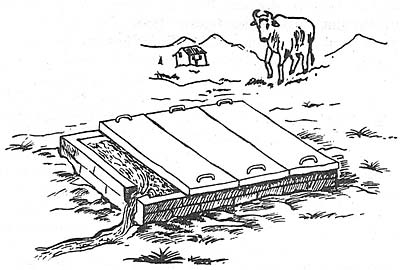
8. Construction of Inlet Pit
The inlet pit is constructed to mix dung and water. This can be constructed with or without a mixing device. Installation of a mixing device is preferable not only because it makes plant operation easier for the user but also because it improves the quality of mix. When a mixer is installed it has to be firmly attached to the structure, easy to operate, effective in the mixing process and the steel parts in contact with the dung are to be galvanized.
The top of the structure should not be more than one meter high from the ground level and both inside and outside of the pit has to be covered with a smooth layer of plaster (Mix: 1 cement-3 sand).
The bottom of the tank must be at least 5 cm above the outlet overflow level. The position of the inlet pipe in the floor must be such that a pole or rod can enter through it without obstructions. For the same reason the inlet pipe must be without bends.
Even though mixing device is not installed, the inlet pit should be round in shape as this is more economical material-wise and easier for hand mixing.
In case of toilet attachment to the plant it is better to construct without siphon or trap as the pan with siphon needs more water which may result excess water inside the digester. It is also not possible to de-block the pipe when the toilet has a trap. The toilet should not be farther than 45 degrees from the hart line. Additionally, the toilet pan level should be at least 25 cm above the outlet overflow level.

9. Lay-out of Pipeline
The gas pipe conveying the gas from the plant to users point is vulnerable for damages by people, domestic animals and rodents. Therefore, only light quality galvanized iron pipe should be used which must be, where possible, buried 1 foot below ground level. Fittings in the pipeline must be sealed with zinc putty, teflon tape or jute and paint. Any other sealing agent, like grease, paint only, soap etc. must not be allowed. To reduce the risk of leakage, the use of fittings, specially unions, should be kept to a necessary minimum. No fittings should be placed between the main gas valve and the dome gas pipe.
The biogas coming from the digester is saturated with water vapor. This water vapor will condense at the walls of the pipeline. If this condense water is not removed regularly, it will ultimately clog the pipeline. Hence, a water drain has to be placed in the pipeline. The position of the water drain should be vertically below the lowest point of the pipeline so that water will flow by gravity to the trap. Water can be removed by opening the drain. As this has to be done periodically, the drain must be well accessible and protected in a well, maintained drain pit.
For connecting burners with gas pipelines, use of transparent polyethylene hose must be avoided. Only neoprene rubber hose of the best quality should be used.
As soon as there is gas production, all joints and taps must be checked for leakage by applying a thick soap solution. If there is leakage the foam will either move or break.
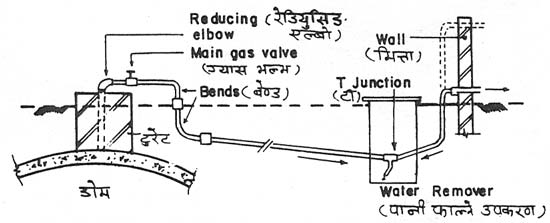
10. Compost Pits
Compost pits are an integral part of the biogas plant; no plant is complete without them. A minimum of 2 compost pits must be dug near to the outlet overflow in such a way that the slurry can run freely into the pits. Enough earth body must remain however, at least 1 meter, between the pits and the outlet chamber to avoid cracking of the chamber walls. The total volume of the compost pits must be at least equal to the plant volume.
To make a potent and easy to use as fertilizer, the compost pits should be filled with agricultural residues together with the slurry from the plant.
The earth coming from digging the compost pits can be used for backfilling of the inlet and outlet chamber and for top filling on the dome.
For proper insulation during the cold season and as counter weight against the gas pressure inside, a minimum top filling of 40 cm compacted earth is required on the dome. If, e.g. because of high ground water table, the plant is not positioned deep enough, the top filling will be prone to erosion due to wind and rain. In these cases proper protection, i.e. with a dry stone circular wall, has to be applied.
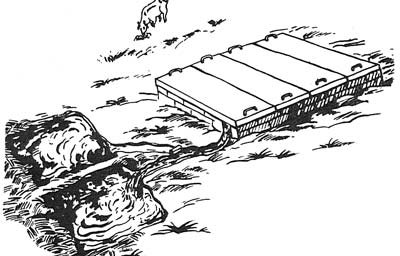
If the concerned mason and plumber strictly follow the above described instructions during the construction phase, the complete plant will be of high quality. Hence, the plant owner will be benefitted ultimately from the investment and positive return will be achieved as per the expectations. This again will persuade his relative and neighbors to install a biogas plant as well, while a poorly constructed plant will do harm to the reputation of biogas technology.
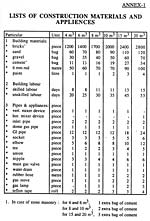
Bigger image
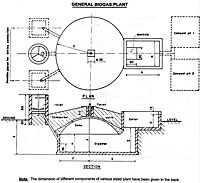
Bigger image






























